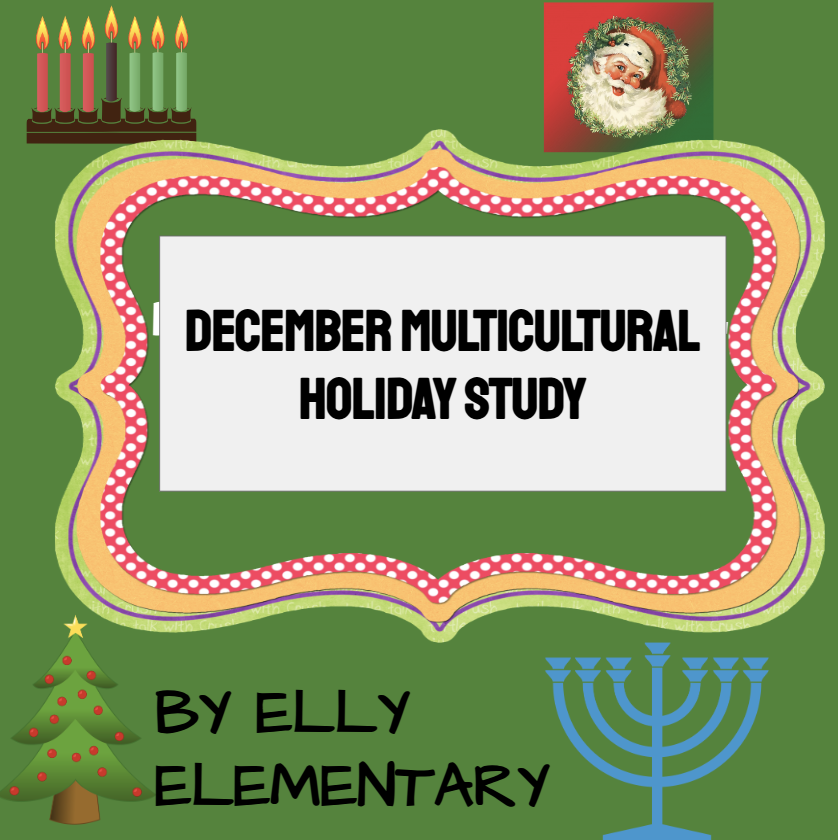December is the perfect time of year for children to learn about and explore holidays that cultures celebrate such as Hanukkah, Kwanzaa and, of course, Christmas. You can create many fun learning experiences that they will rremember for years to come.
HANUKKAH
Teaching children about Hanukkah can be a meaningful and fun way to introduce them to Jewish traditions, history, and culture.
Here are some engaging approaches:
1. Explain the Story of Hanukkah
- Share the story of the Maccabees, the rededication of the Temple, and the miracle of the oil lasting eight days. Use age-appropriate language or picture books such as Hanukkah Bear by Eric A. Kimmel.
- Use visual aids like a map of ancient Israel or illustrations of the Temple.
2. Teach About the Menorah
- Explain the significance of lighting the menorah and its nine candles (eight for the days of the miracle and one shamash, or helper candle).
- Have children create their own menorahs using craft materials.
3. Explore Hanukkah Symbols
- Dreidel Game: Teach children how to play dreidel, explaining the Hebrew letters (nun, gimel, hey, shin) and their meanings.
- Latkes and Food: Discuss the importance of fried foods like latkes and sufganiyot (jelly-filled doughnuts) to commemorate the oil miracle.
4. Hands-On Crafts
- Make paper dreidels or clay versions for younger children.
- Create Star of David ornaments or Hanukkah cards.
- Design and color Hanukkah-themed worksheets.
5. Sing Hanukkah Songs
- Teach simple Hanukkah songs like “I Have a Little Dreidel” or “Oh Hanukkah.”
- Discuss traditional Jewish music and its significance.
6. Integrate Games and Activities
- Organize a Hanukkah-themed scavenger hunt.
- Include puzzles or trivia about Hanukkah customs.
7. Explore Cultural Diversity
- Highlight that Hanukkah is just one of many Jewish holidays and discuss its historical and cultural importance.
- Compare Hanukkah traditions around the world.
8. Invite a Guest Speaker
- If possible, invite someone who celebrates Hanukkah to share their experiences and traditions with the class.
9. Celebrate Inclusivity
- Use the opportunity to discuss respecting and appreciating different traditions and beliefs, fostering an inclusive classroom environment.
By incorporating stories, crafts, food, music, and games, children will engage with the traditions and meanings of Hanukkah in a fun and educational way.
KWANZAA
Teaching children about Kwanzaa can be engaging and meaningful by using activities that celebrate its principles, symbols, and cultural heritage. Here’s a simple and comprehensive guide:
1. Explain What Kwanzaa Is
- Share that Kwanzaa is a seven-day celebration from December 26 to January 1 that honors African American heritage and culture.
- Mention that it was founded by Dr. Maulana Karenga in 1966 and is based on African harvest festival traditions.
- Use child-friendly terms and stories to explain how Kwanzaa is about community, family, and values.
2. Introduce the Seven Principles (Nguzo Saba)
- Teach the seven core values, one for each day of Kwanzaa:
- Umoja (Unity) – Coming together as a family and community.
- Kujichagulia (Self-Determination) – Believing in yourself and making good choices.
- Ujima (Collective Work and Responsibility) – Helping each other and solving problems together.
- Ujamaa (Cooperative Economics) – Supporting local businesses and sharing resources.
- Nia (Purpose) – Setting goals and making life meaningful.
- Kuumba (Creativity) – Using your imagination to make the world better.
- Imani (Faith) – Believing in yourself, your family, and your community.
- Use real-life examples to relate these principles to children’s experiences.
3. Explore Kwanzaa Symbols
- Show or create symbols associated with Kwanzaa:
- Kinara: The candle holder with seven candles (black, red, green).
- Mishumaa Saba: The seven candles representing the principles.
- Mazao: Fruits and vegetables symbolizing harvest and hard work.
- Mkeka: The woven mat as a foundation for the other symbols.
- Zawadi: Handmade or thoughtful gifts to share with loved ones.
- Let children make their own kinara or mkeka mats using craft supplies.
4. Engage with Hands-On Activities
- Crafts:
- Make a paper kinara with construction paper candles.
- Weave paper mats in Kwanzaa colors (red, black, green).
- Music and Dance:
- Listen to African drumming and traditional songs, encouraging movement or rhythm games.
- Teach a simple African-inspired dance.
- Cooking:
- Prepare simple Kwanzaa-inspired recipes like cornbread or fresh fruit salads.
5. Read Books and Share Stories
- Use books like My First Kwanzaa by Karen Katz or Seven Spools of Thread by Angela Shelf Medearis to bring Kwanzaa to life.
- Share folk tales from African cultures to enrich understanding.
6. Teach Through Play
- Play a game where children match the principles to their meanings.
- Create a scavenger hunt with Kwanzaa symbols.
7. Host a Classroom Kwanzaa Celebration
- Light a candle each day and discuss the principle it represents.
- Decorate the room with African-inspired patterns or Kwanzaa colors.
- Encourage children to share something they’re thankful for or a goal they have for the future.
8. Promote Inclusivity and Understanding
- Emphasize that while not everyone celebrates Kwanzaa, its values—such as unity, creativity, and helping others—are universal.
- Encourage children to appreciate cultural diversity and learn about traditions different from their own.
By combining storytelling, crafts, music, and meaningful discussions, children can gain a rich understanding of Kwanzaa and its focus on family, community, and culture.
Teaching children about Christmas can be a joyful and educational experience, helping them understand the holiday's traditions, history, and significance. Here are engaging ways to teach about Christmas:
1. Share the Story of Christmas
- Religious Perspective:
- Explain the Christian story of Christmas, focusing on the birth of Jesus in Bethlehem, Mary and Joseph, the angels, and the shepherds.
- Use a children’s Bible or picture books like The First Christmas by Tomie dePaola.
- Secular Traditions:
- Discuss how Santa Claus, gift-giving, and Christmas trees became part of the celebration.
2. Explore Christmas Traditions Around the World
- Teach about how Christmas is celebrated differently in various countries (e.g., Christmas markets in Germany, piñatas in Mexico, and Christmas crackers in the UK).
- Create crafts inspired by global traditions, such as paper lanterns from the Philippines or straw ornaments from Scandinavia.
3. Incorporate Symbols and Decorations
- Christmas Tree: Discuss its origins and let children make mini trees using craft supplies.
- Nativity Scene: Set up a nativity scene and explain the characters’ roles.
- Candy Canes: Share the symbolism of the candy cane’s shape and colors.
4. Read Christmas Books
- Choose age-appropriate Christmas stories like:
- The Polar Express by Chris Van Allsburg
- How the Grinch Stole Christmas! by Dr. Seuss
- Bear Stays Up for Christmas by Karma Wilson
- Discuss the lessons from the stories, such as kindness, generosity, and the spirit of giving.
5. Sing Christmas Songs
- Teach classic carols like Silent Night or Jingle Bells.
- Incorporate movement or instruments to make the singing interactive and fun.
6. Engage with Christmas Crafts
- Make paper snowflakes, Christmas cards, or ornaments.
- Create a "handprint" Christmas tree or a collage of holiday symbols.
7. Highlight the Spirit of Giving
- Discuss the tradition of gift-giving and its connection to kindness and generosity.
- Organize a classroom charity project, such as making cards for a local hospital or collecting toys for those in need.
8. Bake Holiday Treats
- Involve children in making simple Christmas treats like sugar cookies or gingerbread people.
- Discuss how food plays a role in holiday celebrations.
9. Watch Christmas Movies
- Show short, child-friendly movies like A Charlie Brown Christmas or Frosty the Snowman.
- Use the movies as a springboard to talk about the themes of friendship and joy.
10. Emphasize Inclusion and Respect
- Teach that not everyone celebrates Christmas and introduce other holidays observed during the season, like Hanukkah and Kwanzaa.
- Encourage children to share their own family traditions, fostering an understanding of diverse celebrations.
By blending storytelling, songs, crafts, and discussions, you can create a festive and inclusive way to teach children about Christmas, focusing on its values of love, generosity, and community.
Check out my DECEMBER MULTICULTURAL UNIT for many ideas on learning and sharing these special December holidays.

What is your favorite holiday and why? Comment below.
Check out my store, Elly Elementary, for all your K-5th grade curriculum needs.
Join me on Facebook and Instagram. Let me know if you are looking for anything in particular. (Email: ellyelementary@gmail.com)
HAPPY HOLIDAYS TO ALL FROM ELLY ELEMENTARY !



Comments ()